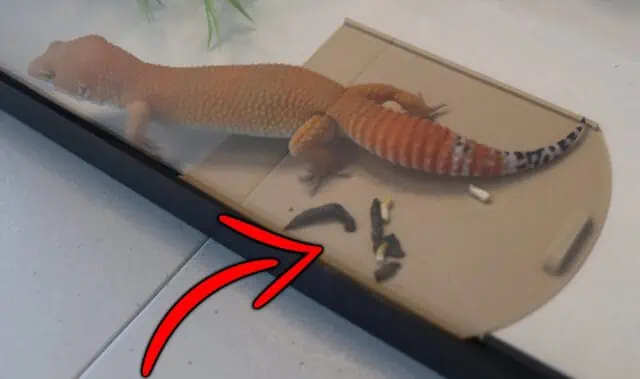Understanding leopard gecko poop is essential for pet owners. This waste provides vital clues about the health, diet, and overall well-being of these reptiles. Analyzing the color, consistency, and frequency of your gecko’s droppings can help detect early signs of potential health issues.
Normal Poop Appearance: Healthy leopard geckos have poop that consists of dark brown solid waste and white/yellowish urates. Deviations such as soft stool or unusual colors like green could be a sign of dietary or health issues.
Frequency Matters: Adult geckos typically poop two to three times a week. Younger geckos may poop daily due to faster metabolism. Extended periods without bowel movements should be monitored, especially in adults.
Dietary Impact: Rapid dietary changes, especially introducing new insects too quickly, or maintaining a fatty diet can result in soft or yellowish poop. A balanced diet is essential for good health.
Tank Cleanliness: Keeping the tank clean, especially after spotting poop, is crucial for the gecko’s health. A dirty environment can increase the risk of bacterial infections and other health concerns.
Seek Expert Advice for Irregularities: If you observe undigested insects, bloody stool, or consistently soft poop, it’s time to consult a veterinarian. Early intervention can prevent more severe health issues.
What Does Normal Leopard Gecko Poop Look Like?
Leopard geckos, like all reptiles, produce waste as part of their natural bodily functions. Being familiar with the appearance of their normal poop is crucial for pet owners. It aids in recognizing any changes which might indicate potential health issues.
A typical leopard gecko poop has distinct parts. The waste part is usually of a dark brown color and resembles the fecal matter of other animals. This solid waste is a result of the food they consume. Adjacent to this, you will often find the uric acid waste. Unlike mammals, reptiles excrete a semi-solid, paste-like uric acid instead of liquid urine. This portion of the waste is commonly referred to as white/yellowish urates.
To summarize, the traits of a healthy leopard gecko poop include:
- Solid waste of a dark brown color.
- Presence of white or yellowish urates, representing the uric acid waste.
- Absence of any liquid, ensuring that the waste is firm and not runny.
Does Leopard Gecko Poop Smell?
All animals produce waste, and often, it comes with a distinct smell. Leopard geckos are no exception. The smell of leopard gecko poop can vary based on several factors. Predominantly, the diet and health of the gecko play a significant role in determining the odor intensity. Fresh leopard gecko poop might have a mild scent, but it shouldn’t be overwhelmingly foul.
One primary reason for an unpleasant odor is the presence of bacteria. A buildup of bacteria can result from infrequent habitat cleaning or a diet that isn’t balanced. Feeding your gecko a balanced diet ensures that its digestive system functions properly, reducing the chances of foul-smelling waste.
Addressing the smell involves a two-fold approach. Firstly, cleaning the habitat regularly is crucial. It not only eliminates the immediate source of the smell but also prevents bacterial buildup. Secondly, ensuring your gecko has a balanced diet can significantly reduce the intensity of the odor. It’s essential to monitor the food intake and adjust as needed to maintain optimal health.
How Many Times Should Leopard Geckos Poop Per Day?
The frequency of a leopard gecko’s bowel movements can provide valuable insights into its health and well-being. This frequency varies mainly based on the age and size of the gecko.
Babies and juveniles have a faster metabolism compared to their adult counterparts. Due to this increased metabolic rate, they typically poop once a day. Their bodies are rapidly growing, and they process food at a quicker pace, leading to more frequent bowel movements.
On the other hand, adult leopard geckos have a slower metabolic rate. They usually defecate two to three times a week. It’s crucial for owners to be aware of this average frequency to detect any irregularities promptly.
How Long Can A Leopard Gecko Go Without Pooping?
Leopard geckos have varying bowel movement frequencies depending on their life stage. It’s essential to recognize what’s normal for your gecko and when there might be a cause for concern.
Baby and juvenile leopard geckos typically have daily bowel movements due to their higher metabolic rates. If they go more than a couple of days without pooping, it might be an indication of an issue. In contrast, adult leopard geckos generally defecate two to three times a week. If an adult goes more than a week without a bowel movement, it’s time to investigate potential causes.
One common issue that can affect the poop frequency is constipation. Constipation in leopard geckos can result from various factors, including low tank temperatures and inadequate hydration. A tank that’s too cold can slow down the gecko’s metabolism, leading to infrequent bowel movements. Similarly, insufficient hydration can harden the feces, making it difficult for the gecko to excrete.
To address constipation:
- Ensure the tank’s temperature is within the appropriate range for leopard geckos.
- Provide a fresh and consistent water source to maintain proper hydration.
- If the problem persists, consider seeking advice from a veterinarian specializing in reptiles.
Signs of Digestive Trouble in Leopard Gecko’s Poop
Digestive issues in leopard geckos can manifest in various ways. Recognizing these signs early can make a significant difference in addressing potential health concerns. From undigested food particles to unusual stool colors, understanding these indicators ensures that your gecko receives timely care and remains in optimal health. Health issues may manifest in any number of ways, even in a change in the skins color.
Undigested Insects
Finding undigested insects in a leopard gecko’s poop can be concerning for pet owners. This occurrence may stem from several causes. Improper tank temperatures can hinder the gecko’s ability to digest food properly. When the environment is too cold, the metabolic processes slow down, leading to undigested food in the droppings. Another cause could be impaction, where the gecko consumes its substrate, leading to blockages in the digestive tract. Additionally, parasite infections can disrupt the digestive system, resulting in undigested food.
Owners should be vigilant for signs like visible substrate in the poop or any regurgitated matter. These can be clear indicators of digestive issues. If undigested insects become a recurring sight, some recommended actions include:
- Ensuring the tank has optimal basking temperatures to facilitate digestion.
- Considering a switch to a different substrate to prevent ingestion and potential impaction.
- Consulting a veterinarian for possible parasite infections and getting appropriate testing.
Soft Stool
Soft stool in leopard geckos can be a clear sign of underlying health concerns. While occasional soft stools might not be alarming, consistent occurrences should be taken seriously. One common cause is a change in diet. Introducing new insects too quickly or feeding them a diet that’s not balanced can result in softer feces. The digestive system of the gecko might not adjust swiftly to sudden dietary changes, leading to this issue.
Another potential cause is a parasitic infection. Parasites can disrupt the normal digestive processes, causing the stool to soften. Signs that might indicate a parasitic infection include a noticeable decrease in energy, sudden weight loss, or other unusual behaviors. A weakened immune system can also make the gecko more susceptible to infections, further contributing to soft stool.
Yellow or Green Poop
Observing yellow or green poop in leopard geckos can be startling for many pet owners. Several factors can contribute to this change in stool color. One prevalent cause is a fatty diet. Consuming excessive fatty feeder insects or treats can lead to yellowish droppings. Similarly, a mineral overdose, especially from supplements, can result in greenish feces. Sometimes, abrupt dietary modifications without a gradual introduction can also lead to these unusual colors in the poop.
To prevent yellow or green stools and ensure the health of your leopard gecko:
- Provide a balanced diet with the right mix of nutrients.
- Limit the intake of fatty feeder insects and avoid using them as frequent treats.
- Ensure proper hydration by offering fresh water consistently.
- If using supplements, ensure they’re given in the correct dosage and not excessively.
Changes in Bowel Movements
Leopard geckos, like all living creatures, have a typical pattern when it comes to their bowel movements. However, any deviation from this pattern can indicate potential digestive troubles. Some symptoms that may raise concerns include the presence of undigested insects in their poop. This can be an indication of issues such as improper tank temperatures or impaction.
Another warning sign is soft stool, which might result from dietary changes or parasitic infections.
Observing yellow or green poop can be a result of a fatty diet or a mineral overdose, while bloody stool is a clear alarm that requires immediate attention, possibly due to parasitic infections or internal injuries.
Bloody Stool
Bloody stool in leopard geckos is a cause for immediate concern. Such an occurrence often indicates underlying health issues that require prompt attention.
One of the primary causes of bloody poop in leopard geckos is parasitic infection. These infections not only affect the digestive system but can also lead to other symptoms. A noticeable decreased appetite and weight loss often accompany these infections.
It’s imperative to consult a veterinarian if you observe bloody stool in your leopard gecko. A trained professional can provide a proper diagnosis and recommend appropriate treatment.
In many cases, the vet might perform a fecal float to check for parasites. If there’s a suspicion of Cryptosporidiosis, commonly referred to as Crypto, a special test is necessary to confirm the diagnosis.
White Poop
White poop in leopard geckos can be perplexing for many pet owners. This unusual stool color can result from the gecko consuming its shed skin, a natural behavior exhibited by many reptiles. Another possible cause is the ingestion of substrate, like sand, which the gecko might accidentally consume while feeding or exploring its habitat.
It’s essential for owners to be proactive when noticing white poop. One of the first steps to consider is to remove any loose substrate from the gecko’s habitat to minimize the risk of ingestion. Furthermore, observing the gecko for signs of regurgitation is crucial. Regurgitated food can indicate various issues, including low tank temperatures, the presence of internal parasites, or other digestive problems.
How to Clean Leopard Gecko Poop?
Cleaning leopard gecko poop is a fundamental aspect of maintaining their habitat. A clean environment ensures the health and well-being of your gecko. Here’s a step-by-step guide on the cleaning process:
- Preparation: Before you begin, ensure you have all necessary cleaning supplies ready. This might include gloves, a small scoop or tweezers, disinfectant wipes or spray, and fresh substrate if needed.
- Removal: Gently pick up the leopard gecko and place it in a secure, temporary container. This ensures the gecko’s safety during the cleaning process. Next, using the scoop or tweezers, carefully remove the poop from the tank.
- Inspect the Substrate: Depending on the type of tank substrate you use, you might need to replace a portion or all of it. Loose substrates, like sand, can hold onto waste, making it harder to spot and clean. In such cases, consider changing a portion of the substrate regularly.
- Disinfect: After removing the poop and affected substrate, use a reptile-safe disinfectant to clean the spot. This step is crucial in preventing bacterial growth and ensuring the tank remains hygienic.
- Reintroduce the Gecko: Once the tank is clean and dry, carefully place the leopard gecko back into its habitat. Ensure the environment is safe and free from any cleaning residue.
The gecko’s age and health can influence the frequency of cleaning. Younger geckos might produce waste more often, requiring more frequent cleanings. Additionally, a sick gecko might have diarrhea or other irregularities, necessitating more thorough cleaning.
Maintaining a clean tank is of utmost importance. A dirty tank can become a breeding ground for bacteria and parasites, posing significant health risks to the gecko. Regular cleaning not only ensures the gecko’s health but also provides a pleasant environment for them to thrive in.
How to Collect a Sample of Leopard Gecko Poop To Take To The Vet
In some cases, the vet might ask you to bring him a sample of poop from the Leopard Gecko, to use as a diagnosis tool when there are issues such as underbite (might be MBD) or an unusual stool color.
Collecting a leopard gecko poop sample for veterinary analysis is a straightforward process, but it’s essential to ensure the sample is uncontaminated. First, ensure you have a clean, sealable plastic bag or a small container.
Once your gecko defecates, use a clean plastic spoon or tweezers to promptly collect the sample, ensuring you don’t touch it directly. If possible, gather both the solid waste and the white/yellowish urates. Place the sample in the bag or container, sealing it securely.
It’s best to refrigerate the sample if you can’t take it to the vet immediately. However, try to deliver the sample within 24 hours, as a fresh sample will provide the most accurate results.
Always label the container with the date, your gecko’s name, and any observed abnormalities for the vet’s reference.







